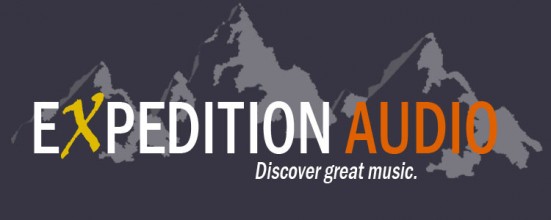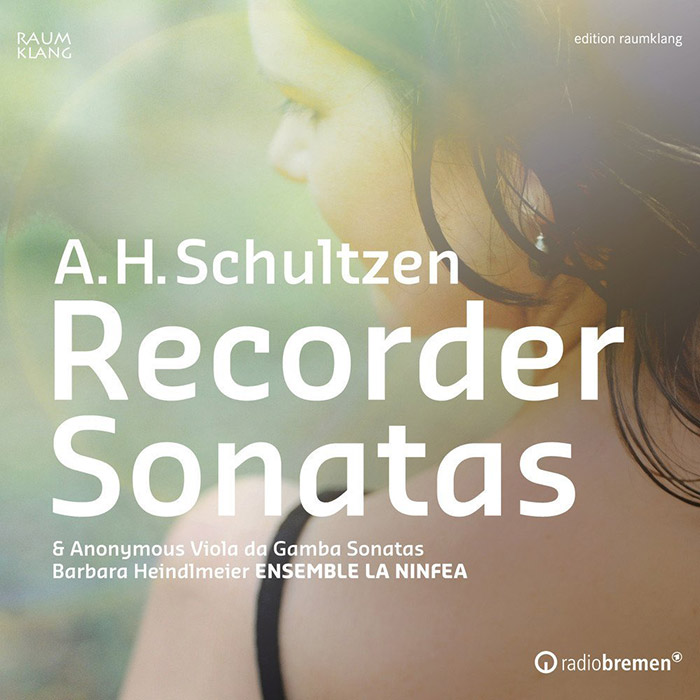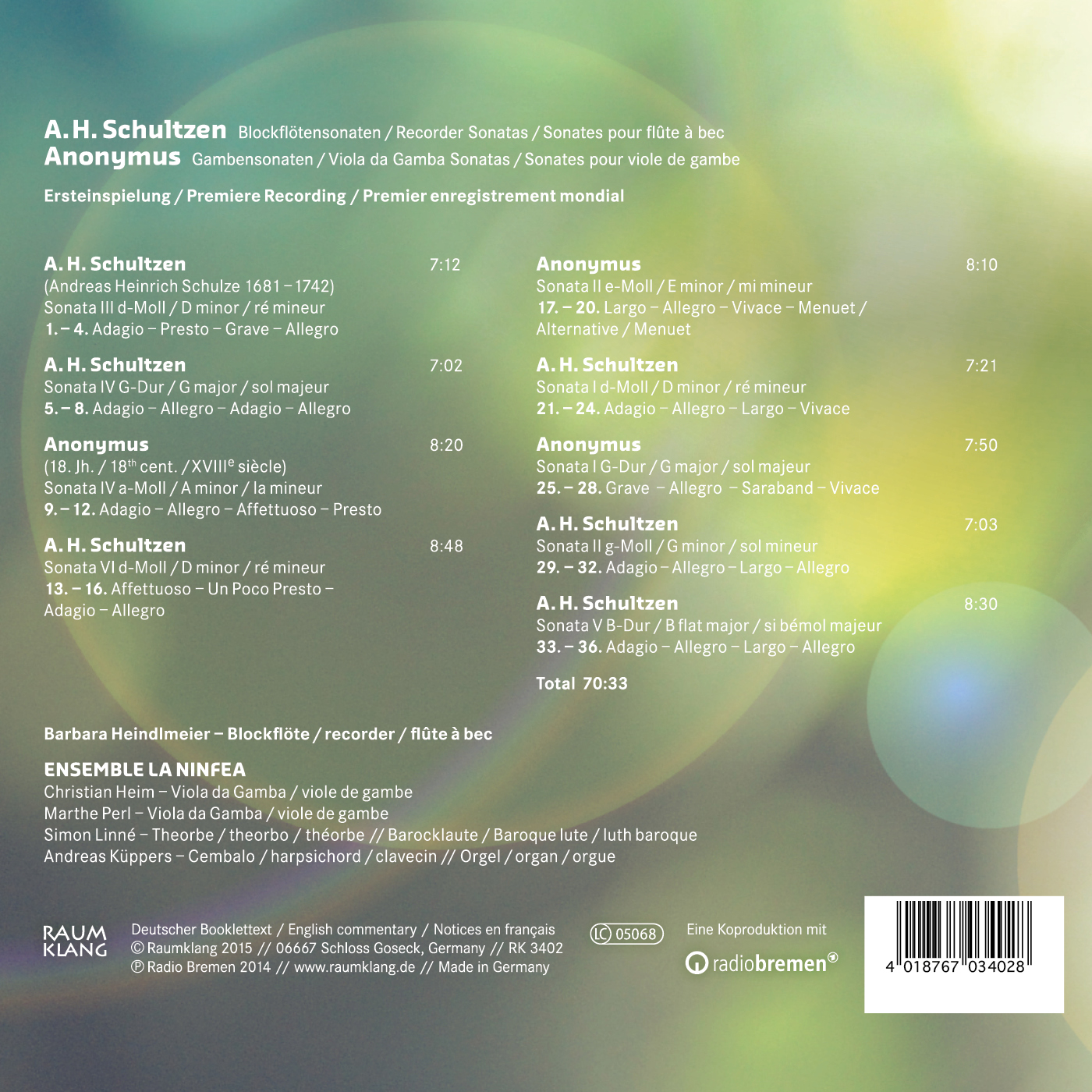Share This
Album at a Glance
Tags
Related Posts
- Roman Statkowski (1859-1925): Piano Music / Barbara Karaskiewicz
- Walter Braunfels: Orchestral Works, Vol. 2 / BBC Concert Orchestra; Johannes Wildner
- Steve Wilson & Wilsonian’s Grain: Live in New York - The Vanguard Sessions
- Music from America & Abroad for Oboe, Bassoon & Piano / John Dee, oboe; Timothy McGovern, bassoon; Cara Chowning, piano
A.H. Schultzen (1682-1762): Recorder Sonatas / Ensemble la Ninfea, Barbara Heindlmeier, recorder
Posted by Elaine Fine on Apr 30, 2015 in Baroque | 0 comments
The music of A.H. Schultzen (1681-1742) is a relatively new and exciting addition to the 18th-century recorder literature. Schultzen's music first came to light in a 2001 article in the Journal of the American Recorder Society. A contemporary and compatriot of J.S. Bach and G.P. Telemann, Schultzen wrote difficult, brilliant, and progressive Italianate music for the recorder. The present album, released in 2015 on the German Raumklang label, intersperses six of the composer’s recorder sonatas with three anonymous viola da gamba sonatas of apparently similar provenance; these performances by recorder player Barbara Heindlmeier and the period instrument ensemble La Ninfea represent the first appearance of this repertoire on disc.
The sonatas’ original publication, made by the Amsterdam firm of Roger in 1703, may be found in the online archives of the International Music Score Library Project. The score indicates that these pieces were intended for recorder with harpsichord and bassoon continuo. For the present recording, the musicians of La Ninfea use a continuo of harpsichord, viola da gamba, theorbo, and organ in various combinations. The performers occasionally depart from the score by adding several measures of introduction derived from the continuo, which I find very appropriate and effective, particularly in Sonata No. 3. The delicate interplay between soloist and continuo reaches a height of expressiveness in the Grave of this sonata, wherein the organ’s right hand performs a sort of slow, intimate dance with the ornamented recorder part, embellishing and impelling the melodic line. The ensemble performs the G minor Sonata with harpsichord and theorbo for most of the movements, but for the Largo, which is a beautiful Chaconne, the recorder is accompanied by lute alone.
The viola da gamba sonatas that comprise the remainder of this disc were found in the family library of the crown prince of Württemberg (the music is now in the library of the University of Rostock). Again, these musicians make excellent continuo choices, sometimes using another viola da gamba to reinforce the bass line, and sometimes using lute. It’s difficult to tell if these anonymous pieces may have been written by the same composer, but I find the A minor sonata particularly distinctive.
La Ninfea, based in Bremen, Germany, is an extremely expressive group of musicians. Barbara Heindlmeier has a lovely sound and extraordinary articulation which she uses to meet the considerable demands of this music. Her ornamentation is marvelous, and I appreciate the way she occasionally uses finger vibrato on sustained notes. She and the viola da gambists play their solo parts with whimsy and taste, and the continuo playing is solid, yet light and flowing. All the instruments are modern copies of 18th-century instruments, and all the music is pitched at A=415.
Signore A. H. Schultzen’s collection of sonatas remains a mystery to musicologists of our time. The Amsterdamer publisher Roger included it in his catalog of 1737, though it is mentioned as early as 1704 in Josiah Burchett's Memoires de tout ce qui s'est passé de plus considérable sur mer.The only surviving copy today can be found in the Bibliothèque nationale de France in Paris, which kindly made it available to us for this recording.
In 2001, Patricio Portell presented the work in American Recorder Magazine, establishing the theory that it was the earliest collection of sonatas published with the professional recorder player in mind. Compared to the works of other composers of his time, which were written for amateur musicians, one notices that Schultzen demands much more of his players and utilizes the recorder's possibilities to a much greater extent. Portell was not able, however, to reveal anything about the composer's identity.
Our own research has brought us to the conclusion that the mysterious A. H. Schultzen is probably Andreas Heinrich Schulze. A certain “A. Schultsen" is mentioned in Zedlers Universal-lexikon (1732-1754) and Walthers Musikalisches Lexikon (1732) as an author of two collections of sonatas: the six sonatas for recorder that appear on this recording, and six more for oboe, which have presumably been lost. It is quite possible that the same person could be referred to by different names, as spellings of proper names were not yet standardized in the eighteenth century. It is interesting to note that Walthers Musikalisches Lexikon contains a separate entry on Andreas Heinrich Schulze, born in Braunschweig in 1681 and organist in Hildesheim as of 1706. From this article, we learn that Schulze was a student at the Hildesheimer Gymnasium Andreanum, which Georg Philipp Telemann attended from 1697 to 1701. Even in the later years of his life, Telemann kept in contact with the Andreanum, making it possible that the two composers knew each other personally.
The sonatas have several noteworthy features: the discant and continuo voices are often very melodic in design, making them equal partners, as in a duet. This "typically German" element is further influenced by many aspects of Italian style. The noticeable individuality of the different sections in terms of their compositional style and variety of affects lends each sonata a distinctive air.
Princess Louisa Frederica, daughter of Friedrich Ludwig, the crown prince of Württemberg, brought the family music library with her when she moved to Mecklenburg-Schwerin to marry its future duke, Friedrich II. The collection can now be found in the library of the University of Rostock. Among the pieces to be found there is a set of anonymous sonatas that has garnered very little attention up until now. They were composed in the eighteenth century, are strongly Italian in style and are thus something of an anomaly in the viola da gamba repertoire.
- Barbara Heindlmeier & Christian Heim (Translation: Julie Comparini)
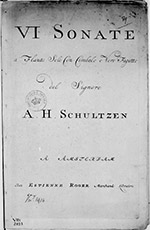 Schultzen Manuscript |
A.H. Schultzen, composer Little is known about the life and work of A.H. Schultzen; indeed, his existence is known only through the attribution to this name of a set of virtuosic and rather idiosyncratic recorder sonatas. Historical records indicate that the mysterious Schultzen may in fact be the German Baroque composer known elsewhere as Andreas Heinrich Schulze. The music theorist Johann Gottfried Walther, cousin and nearly exact contemporary of J.S. Bach, devotes an entry to Schulze in his Musicalisches Lexicon (Leipzig, 1732), stating that his subject was born in Braunschweig, Saxony in 1681, and held a post as organist in Hindesheim by 1706. After this, few if any record of Schulze’s life and work may be found, and as such it is not possible to determine with any certainty that these two approximate contemporaries with nearly identical names are indeed the same figure. Source: Album liner notes
|
|
Barbara Heindlmeier |
Barbara Heindlmeier, recorder Barbara Heindlmeier grew up in Upper Bavaria and now lives in Bremen. Her program concepts aim to explore the intense emotional affects of seventeenth- and eighteenth-century music and make them perceptible to a modern audience, with an eye to discovering and revealing the beauty in their details. Library research of original recorder repertoire, attention to historical performance practice and collaboration with contemporary composers are a vital part of her work. Barbara studied recorder with Carin von Heerden and Dorothee Oberlinger at the Mozarteum in Salzburg and with Han Tol at the Hochschule für Künste in Bremen, where she also currently studying cornetto with Gebhard David. In addition to Ensemble La Ninfea, which she co-founded and which remains her primary artistic devotion, she has worked with the RIAS Kammerchor, Sirius Viols (Hille Perl) and Ensemble Weser-Renaissance. |
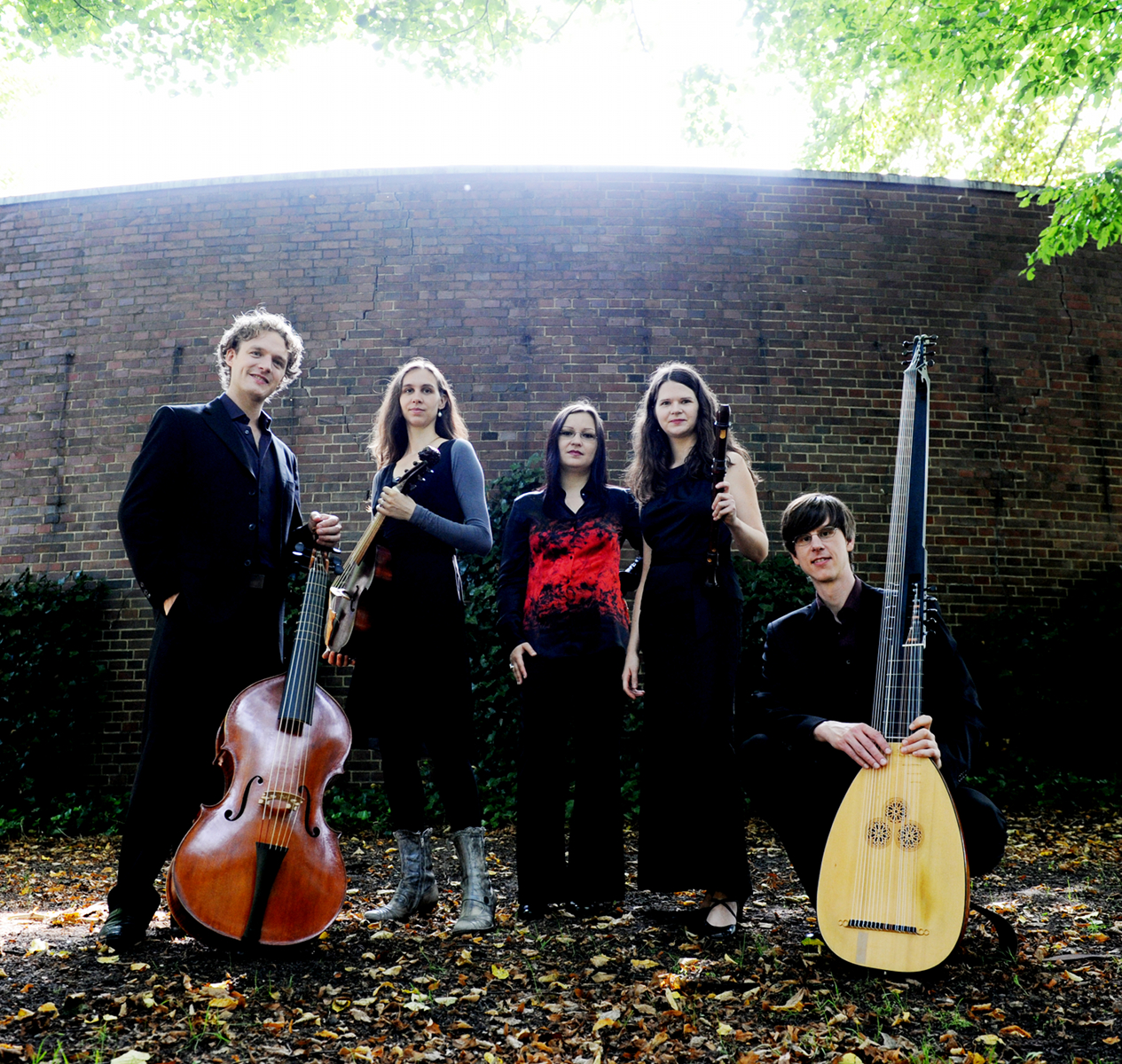 Ensemble La Ninfea |
Ensemble La Ninfea La Ninfea (Italian for “water lily”) performs chamber music of the seventeenth and eighteenth centuries, particularly rediscoveries of forgotten works. Their flexible formation allows for a wide spectrum of baroque tone colors. Individually, the members of La Ninfea have received competition prizes and other awards and appeared with numerous prominent early music ensembles and soloists, who inspired them to create their own ensemble. Sono amante, their debut CD of newly rediscovered cantatas and chamber music by the Bononcini brothers featuring soprano Ulrike Hofbauer, was released in October 2011 on Thorofon Records and received with acclaim by audiences and critics alike. Source: http://www.ensemble-laninfea.de/ |
![]() About Elaine Fine
About Elaine Fine
Twitter •
| Thinking about purchasing this album?
Follow this link for more album details or to make the purchase. Buy it now |
“Not just recommended. Guaranteed.”
We stand behind every album featured on Expedition Audio. Our objective is to take the monetary risk out of music exploration. If you order this album from HBDirect.com and do not like it you can return it for a refund.
C.F. Abel - Sonata II: 3. Presto / Ensemble La Ninfea
